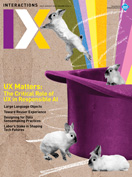Authors:
Mikael Wiberg, Elizabeth F. Churchill
Welcome to the July–August 2024 issue of ACM Interactions! In response to the current third wave of AI, characterized by a society-wide deployment of AI-powered systems, it is increasingly critical to understand and explore approaches to responsible AI (RAI) design and use practices. In short, it is imperative we make sure that these systems are experienced as meaningful, accurate, and trustworthy.
Over the past decade, user experience (UX) has established itself as a practice devoted to the design of such meaningful interactions with digital systems. With an explicit focus on how people experience the presence of and interaction with these technologies, UX has served as an important complement to user interface (UI) design. Given that these systems are becoming increasingly AI-driven, UX engagement is needed to ensure that they are designed to not only automate tasks but also provide a means whereby users can engage directly with the underlying AI components.
Accordingly, in this issue's cover story, "UX Matters: The Critical Role of UX in Responsible AI," Q. Vera Liao, Mihaela Vorvoreanu, Hari Subramonyam, and Lauren Wilcox focus on ways of working with RAI from a UX perspective. They ask fundamental questions: Why and how does UX matter, and what critical role could UX play in establishing RAI? Their view is that UX practitioners can be instrumental in the design and development of RAI practices because UX and RAI share common goals, principles, and perspectives.
Related to this focus on user experience, new columnist Melissa Gregg reflects on what the "reuser experience" could be. She addresses the existing "cradle to grave" linear model behind product ideation and development, and how reuser experience could serve as a goal for designers in their thinking around how to break this model—as product leads, designers, and developers, we can aim for product reincarnations. This could shift how we, as humans, relate to technologies and digital systems, and how we, as designers, connect to the consequences of digital system production and use for our climate and environment.
This issue also includes articles on other emerging practices and sociomaterial interplays, among them "Designing for Data Sensemaking Practices" by Armağan Karahanoğlu and Aykut Coşkun. In "Large Language Objects: The Design of Physical AI and Generative Experiences," Marcelo Coelho and Jean-Baptiste Labrune focus on LLOs, moving from the more common focus nowadays on large language models to consider AI in physical form, and ways of interacting with AI-infused things.
It is clear that the current wave of digitalization, with and without AI, is sweeping across societal institutions globally. This calls for globally inclusive approaches to teaching computational thinking, which Ana Cristina Pires, Filipa Rocha, Tiago Guerreiro, and Hugo Nicolau address in their article "Inclusive Computational Thinking in Public Schools: A Case Study from Lisbon."
This issue's two forum articles also address global issues, in the form of "the cloud." Nataliya Nedzhvetskaya and JS Tan consider labor's stake in shaping cloud-based technology futures through activism, and Ghazal Bangash, Pierre-Adrien Forestier, and Loutfouz Zaman share how the cloud is revolutionizing the gaming world for developers and players alike.
Finally, with Exit's "The Last Pencil?" Renato Verdugo and Scott Minneman highlight a yellow wooden pencil as something that appears ordinary, yet serves as a symbol of creativity. Each pencil in the accompanying image "draws for you, so you don't have to." This thoughtful piece invites us, again, to reflect on what balance we want to have between human interaction and computational automation. Certainly, the most recently launched AI chatbots have invited deep reconsideration around what we as humans want and are good at and what to delegate to computers.
In closing, and as always, we invite you to consider submitting something to Interactions, and please invite others to submit as well. We hope you enjoy the issue!
Mikael Wiberg and Elizabeth F. Churchill
[email protected]
Copyright held by authors
The Digital Library is published by the Association for Computing Machinery. Copyright © 2024 ACM, Inc.








Post Comment
No Comments Found